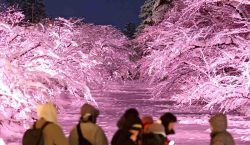
Geiko and maiko dance during the Gion Odori event in Higashiyama Ward, Kyoto.
11:43 JST, December 17, 2022
KYOTO — Kyoto’s geisha districts are at last showing signs of recovery after being hit hard by the COVID-19 pandemic.

Kyoto has five such districts where geiko and maiko entertain, called “kagai,” literally meaning “flower towns.” Geiko, usually called geisha in other regions, are skillful entertainers, while maiko are apprentice geiko. Geiko and maiko are called to “ozashiki” parties, where they add a touch of elegance and entertain the guests.
At the Gion Kaikan theater in Higashiyama Ward on Dec. 1, geiko and maiko in kimono danced gracefully to an accompanying song. This was the “Gion Odori” dance show in the Gion Higashi district, one of the five geiko districts. This year’s performances follow a two-year hiatus due to the pandemic.
Similar shows returned to the stage in the Pontocho and Kamishichiken districts this autumn, reviving seasonal staples of the ancient capital. The other two kagai districts — Gion Kobu and Miyagawacho — are also showing signs of their old vigor.
“Although it was still too early for tour groups, we were able to resume and finish the show with no problem,” said Saburo Nakanishi, the head of the Gion Higashi Kabukai association.
Many business owners hold parties to entertain important clients with performances and hospitality from geiko and maiko. Due to the pandemic, however, the number of such parties declined so drastically that the situation was said to be “the worst in the post-war period.”
Fees for inviting geiko and maiko to parties — called “hana-dai” (pay for flowers) — at one point totaled less than 30% of the amount compared to pre-pandemic levels, though the overall figure has now recovered to between 60% and 70%. According to regular customers, fees for a single geiko or maiko run about ¥30,000 to ¥50,000.
In such ozashiki businesses, there is a custom of refusing first-time visitors who don’t have someone to introduce them, so efforts are underway to increase accessibility.
Late last year, an unusual event was held at a hotel, in which customers enjoyed dinner and dance performances by geiko and maiko, as well as the chance to talk with them. Although not very affordable — tickets were ¥24,000 per person — the event attracted visitors from as far away as the Hokkaido, Kanto and Kyushu regions, filling all 250 or so available seats.
The event was organized by the Kyoto Traditional Art Foundation, or Okini Zaidan, which supports the five geiko districts.
Noriko Kasuya, executive director of the foundation, proudly stresses the brand power of the districts. “Geiko and maiko personify what is unique about Kyoto and have the power to pull people in.”
Schools for geiko, maiko
To maintain this brand power, the districts rely on educational institutions for geiko and maiko. Each kagai has its own school for the entertainers. The Gion Kobu and Miyagawacho districts even have schools incorporated like ordinary private schools.
These schools accept all maiko and geiko at any stage of their career — from maiko who have yet to debut to geiko up to the point they retire. Subjects offered include dancing, traditional music and other performing arts, as well as tea ceremony lessons. Maiko and geiko can take lessons for as many subjects as they want at low tuition rates.
A school in the Miyagawacho district, where 50 students ages 17 to 90 are enrolled, invited a tea master to give a lecture on Nov. 21.
“I’ve become able to move more gracefully. I feel more confident of my movements,” said Kikuyae, 26, a geiko who has been attending the school every week for the past seven years. “I’m grateful for the opportunity to do so many things at the school.”

A geiko, right, practices preparing tea during a tea ceremony lesson in Higashiyama Ward, Kyoto.
Improving infrastructure
Some of the kagai districts are renovating their local theaters for their regular spring and autumn dance performances.
The Gion Kobu district spent more than ¥5 billion on earthquake-proofing its theater, aiming to reopen it next spring. Miyagawacho, meanwhile, is building a new theater to replace the old one, and expects to finish the project by 2025.
For the kagai districts, having their own theaters is not always advantageous in terms of operating costs. However, experts say that these theaters are one of the draws of the districts.
“The entire town serves as a kind of stage set for geiko and maiko,” said Yukiko Matsuda, a visiting researcher at the National Museum of Ethnology. She stresses that in addition to being a hub of traditional industries, Kyoto boasts cityscapes in the kagai districts where old-fashioned theaters are integrated spatially with party establishments.
The districts are also important for the local economy.
In the five districts, the total amount paid to call geiko and maiko to parties is estimated to have been about ¥5 billion per year before the pandemic, according to Kumiko Nishio, a professor at Kindai University. She said the ripple effects are even greater when taking into account the costs of kimono worn by geiko and maiko and meals served at parties.
“Kyoto’s geiko and maiko embody several hundred years worth of history, Japanese hospitality and the essence of traditional Japanese culture,” Nishio said. “They will continue to be a driving force for attracting people to Kyoto.”
5 kagai districts in Kyoto

These districts are areas that boast a large number of “teahouses,” which serve as party venues, and okiya establishments. Okiya provide housing and an education in traditional performing arts and professional etiquette to girls wishing to be geiko and maiko, and dispatch those already trained to parties. After the girls make their debut as maiko, they undertake further training to become geiko, and then leave their okiya to live on their own.
Related Tags
"Features" POPULAR ARTICLE
-

Students Recreate 19th-Century Bento Boxes Made for Ino Tadataka’s Survey Team in Hot Spring Town on Nakasendo Road
-

Santa Claus Delivers Christmas Presents to Penguins at Aquarium in Japan’s Nagasaki Prefecture
-

Sumo Restaurant in Tokyo Teaches Foreign Visitors About the Ancient Sport, with Bouts Between Retired Rikishi
-

Autonomous Passenger Ship Connects Mainland with Remote Island in Seto Inland Sea; World’s 1st Commercially Operated Autonomous Vessel
-

Osaka’s Sumiyoshi Taisha Shrine Bustles with New Year’s Visitors
JN ACCESS RANKING
-

As Chinese Tourists Shun Japan, Hotels and Stores Suffer
-

Osaka-Kansai Expo’s Economic Impact Estimated at ¥3.6 Trillion, Takes Actual Visitor Numbers into Account
-

Japan Govt Adopts Measures to Curb Mega Solar Power Plant Projects Amid Environmental Concerns
-

BOJ Gov. Ueda: Highly Likely Mechanism for Rising Wages, Prices Will Be Maintained
-

Economic Security Panels Debate Supply Chains, Rare Earths; Participants Emphasize Importance of Cooperation Among Allies

























